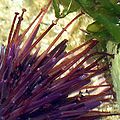Sea urchin
Sea urchins are small, spiny sea creatures that are found in oceans all over the world. They are part of the Echinoderm family, which also includes starfish and sea cucumbers. Sea urchins are known for their round, spiny bodies and their ability to move slowly along the ocean floor.
Anatomy[edit]
Sea urchins have a hard, round shell called a test, which is covered in sharp spines. The test is made up of plates that are fused together, and the spines are attached to these plates. The spines are used for protection, movement, and catching food.
Inside the test, sea urchins have a complex system of organs. They have a mouth located on the underside of their body, which they use to eat algae and other small organisms. They also have a water vascular system, which they use to move and to breathe.
Behavior[edit]
Sea urchins are slow-moving creatures. They use their spines and a series of tube feet to move along the ocean floor. They are primarily nocturnal, and spend most of the day hiding in crevices or under rocks.
Sea urchins are also known for their unique reproductive behavior. They release their eggs and sperm into the water, where fertilization takes place. The resulting larvae are free-swimming and undergo several stages of development before settling on the ocean floor and developing into adult sea urchins.
Human Interaction[edit]
Humans interact with sea urchins in a variety of ways. In some cultures, sea urchins are harvested for their roe, which is considered a delicacy. However, sea urchins can also be a nuisance to humans, as their spines can cause painful injuries. In addition, large populations of sea urchins can damage coral reefs and other marine ecosystems.
Conservation[edit]
Many species of sea urchins are currently threatened by habitat loss, pollution, and overfishing. Conservation efforts are focused on protecting sea urchin habitats and regulating fishing practices.
|
|
|
-
Tripneustes ventricosus (West Indian Sea Egg-top) and Echinometra viridis (Reef Urchin - bottom)
-
Paracentrotus lividus profil
-
Live Sand Dollar trying to bury itself in beach sand
-
Phyllacanthus
-
Urchin
-
Seeigel Saugfuesse (Galicien 2005)
-
Ricci di mare luminosi
-
Sea Urchin test
-
Black Sea Urchin Test
-
Inner surface of black sea urchin test
-
Echinodiscus
-
Phyllacanthus imperialis test
Ad. Transform your life with W8MD's Budget GLP-1 injections from $75


W8MD offers a medical weight loss program to lose weight in Philadelphia. Our physician-supervised medical weight loss provides:
- Weight loss injections in NYC (generic and brand names):
- Zepbound / Mounjaro, Wegovy / Ozempic, Saxenda
- Most insurances accepted or discounted self-pay rates. We will obtain insurance prior authorizations if needed.
- Generic GLP1 weight loss injections from $75 for the starting dose.
- Also offer prescription weight loss medications including Phentermine, Qsymia, Diethylpropion, Contrave etc.
NYC weight loss doctor appointmentsNYC weight loss doctor appointments
Start your NYC weight loss journey today at our NYC medical weight loss and Philadelphia medical weight loss clinics.
- Call 718-946-5500 to lose weight in NYC or for medical weight loss in Philadelphia 215-676-2334.
- Tags:NYC medical weight loss, Philadelphia lose weight Zepbound NYC, Budget GLP1 weight loss injections, Wegovy Philadelphia, Wegovy NYC, Philadelphia medical weight loss, Brookly weight loss and Wegovy NYC
|
WikiMD's Wellness Encyclopedia |
| Let Food Be Thy Medicine Medicine Thy Food - Hippocrates |
Medical Disclaimer: WikiMD is not a substitute for professional medical advice. The information on WikiMD is provided as an information resource only, may be incorrect, outdated or misleading, and is not to be used or relied on for any diagnostic or treatment purposes. Please consult your health care provider before making any healthcare decisions or for guidance about a specific medical condition. WikiMD expressly disclaims responsibility, and shall have no liability, for any damages, loss, injury, or liability whatsoever suffered as a result of your reliance on the information contained in this site. By visiting this site you agree to the foregoing terms and conditions, which may from time to time be changed or supplemented by WikiMD. If you do not agree to the foregoing terms and conditions, you should not enter or use this site. See full disclaimer.
Credits:Most images are courtesy of Wikimedia commons, and templates, categories Wikipedia, licensed under CC BY SA or similar.
Translate this page: - East Asian
中文,
日本,
한국어,
South Asian
हिन्दी,
தமிழ்,
తెలుగు,
Urdu,
ಕನ್ನಡ,
Southeast Asian
Indonesian,
Vietnamese,
Thai,
မြန်မာဘာသာ,
বাংলা
European
español,
Deutsch,
français,
Greek,
português do Brasil,
polski,
română,
русский,
Nederlands,
norsk,
svenska,
suomi,
Italian
Middle Eastern & African
عربى,
Turkish,
Persian,
Hebrew,
Afrikaans,
isiZulu,
Kiswahili,
Other
Bulgarian,
Hungarian,
Czech,
Swedish,
മലയാളം,
मराठी,
ਪੰਜਾਬੀ,
ગુજરાતી,
Portuguese,
Ukrainian














